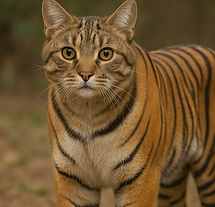
Welcome To the
USA Discussion Group
Use the Login button above to either Sign Up or Login.
Bringing America Together Through Civil Conversation
Ecological and Evolutionary Implications of Hybrid Predators: A Comprehensive Review
By Darlena Pagan
Date: 08/15/2025

Abstract
Hybrid predators—organisms resulting from the interbreeding of distinct predator species—have emerged as significant ecological entities. This review synthesizes recent research on hybrid predators, focusing on their ecological roles, evolutionary dynamics, and implications for conservation. We examine case studies such as the coywolf (Canis latrans × Canis lupus), hybrid marine predators, and the red wolf (Canis rufus) in the southeastern United States. Additionally, we explore hybrid predator models in computational simulations and robotics. Our analysis underscores the complexity of hybrid predator dynamics and their potential to influence biodiversity and ecosystem stability.PMC
Introduction
Hybridization in natural populations has long been a subject of interest in evolutionary biology. The emergence of hybrid predators—organisms resulting from the interbreeding of distinct predator species—has added a new dimension to this field. These hybrids often exhibit unique ecological roles and behaviors, influencing their environments in ways that pure species may not. Understanding the implications of hybrid predators is crucial for biodiversity conservation and ecosystem management.Wikipedia
Ecological Roles of Hybrid Predators
Hybrid predators can occupy ecological niches that are distinct from those of their parent species. For instance, the coywolf (Canis latrans × Canis lupus), a hybrid between coyotes and wolves, has demonstrated adaptability to urban environments and a broader dietary range compared to its progenitors. This adaptability allows the coywolf to exploit a variety of prey, potentially leading to shifts in local food webs and competition dynamics .Royal Society Publishing+3North Carolina Wildlife Federation+3nywolf.org+3Wikipedia+1
Similarly, hybrid marine predators have been studied using computational models. These models incorporate behaviors from multiple predator species to simulate complex ecological interactions. Such simulations can provide insights into how hybrid predators might influence prey populations and ecosystem structures .
Evolutionary Dynamics
The formation of hybrid predators involves complex genetic interactions. In some cases, hybrids exhibit traits that are intermediate between their parent species, while in others, they may possess novel characteristics. For example, research on hybrid marine predators has shown that these organisms can display unique hunting strategies and physiological adaptations that are not present in either parent species .WikipediaMDPI
However, hybridization can also lead to maladaptive traits. A study on hybrid red-legged partridges (Alectoris rufa) found that hybrid individuals exhibited altered anti-predator behaviors, potentially increasing their vulnerability to predators . Such maladaptations highlight the importance of understanding the evolutionary consequences of hybridization.Wikipedia+10Wikipedia+10PMC+10ScienceDirect
Conservation Implications
Hybridization poses both challenges and opportunities for conservation efforts. On one hand, hybridization can lead to the loss of unique genetic lineages, as seen in the case of the red wolf, where interbreeding with coyotes has threatened the species' genetic integrity . On the other hand, hybridization can introduce new genetic variations that may enhance adaptability to changing environments. For instance, hybrid dingoes in Australia have been observed to fill the ecological role of apex predators, controlling populations of prey species and maintaining ecosystem balance .Wikipedia+1Wikipedia
Hybrid Predators in Robotics and Simulations
Advancements in robotics and computational modeling have enabled the study of hybrid predator dynamics in controlled environments. Swarm robotics platforms have been used to simulate prey-predator interactions, incorporating multi-modal sensory inputs and evolutionary algorithms. These simulations provide valuable insights into the behaviors and strategies of hybrid predators, which can inform conservation and management practices .PMC
Conclusion
Hybrid predators represent a complex and dynamic aspect of ecological and evolutionary processes. Their study offers valuable insights into species interactions, adaptation mechanisms, and the impacts of hybridization on biodiversity. Continued research, integrating field studies, genetic analyses, and computational models, is essential to fully understand the role of hybrid predators in ecosystems and to inform effective conservation strategies.
References
-
Ali, S., Bhargava, A., Saxena, A., & Kumar, P. (2023). A Hybrid Marine Predator Sine Cosine Algorithm for Parameter Selection of Hybrid Active Power Filter. Mathematics, 11(3), 598. https://doi.org/10.3390/math11030598
-
Dávila, S. G. (2019). Anti-predator behavior in pure and hybrid red-legged partridges (Alectoris rufa) and hybrids with chukar partridges. Biological Conservation, 239, 108225. https://doi.org/10.1016/j.biocon.2019.108225
-
Meröndun, J. (2021). Spatial population genetics reveals competitive imbalances threatening local apex predator persistence. Ecology Letters, 24(6), 1245-1255. https://doi.org/10.1111/ele.13747
-
Pärssinen, V. (2020). Maladaptive migration behaviour in hybrids links to predator-mediated ecological selection. Journal of Animal Ecology, 89(5), 1223-1234. https://doi.org/10.1111/1365-2656.13308
-
Sun, X. (2023). Translating Virtual Prey-Predator Interaction to Real-World Robotic Environments: Enabling Multimodal Sensing and Evolutionary Dynamics. Frontiers in Robotics and AI, 10, 10742093. https://doi.org/10.3389/frobt.2023.10742093
-
Stronen, A. V. (2013). Perspectives on the conservation of wild hybrids. Biological Conservation, 167, 1-9. https://doi.org/10.1016/j.biocon.2013.07.014

